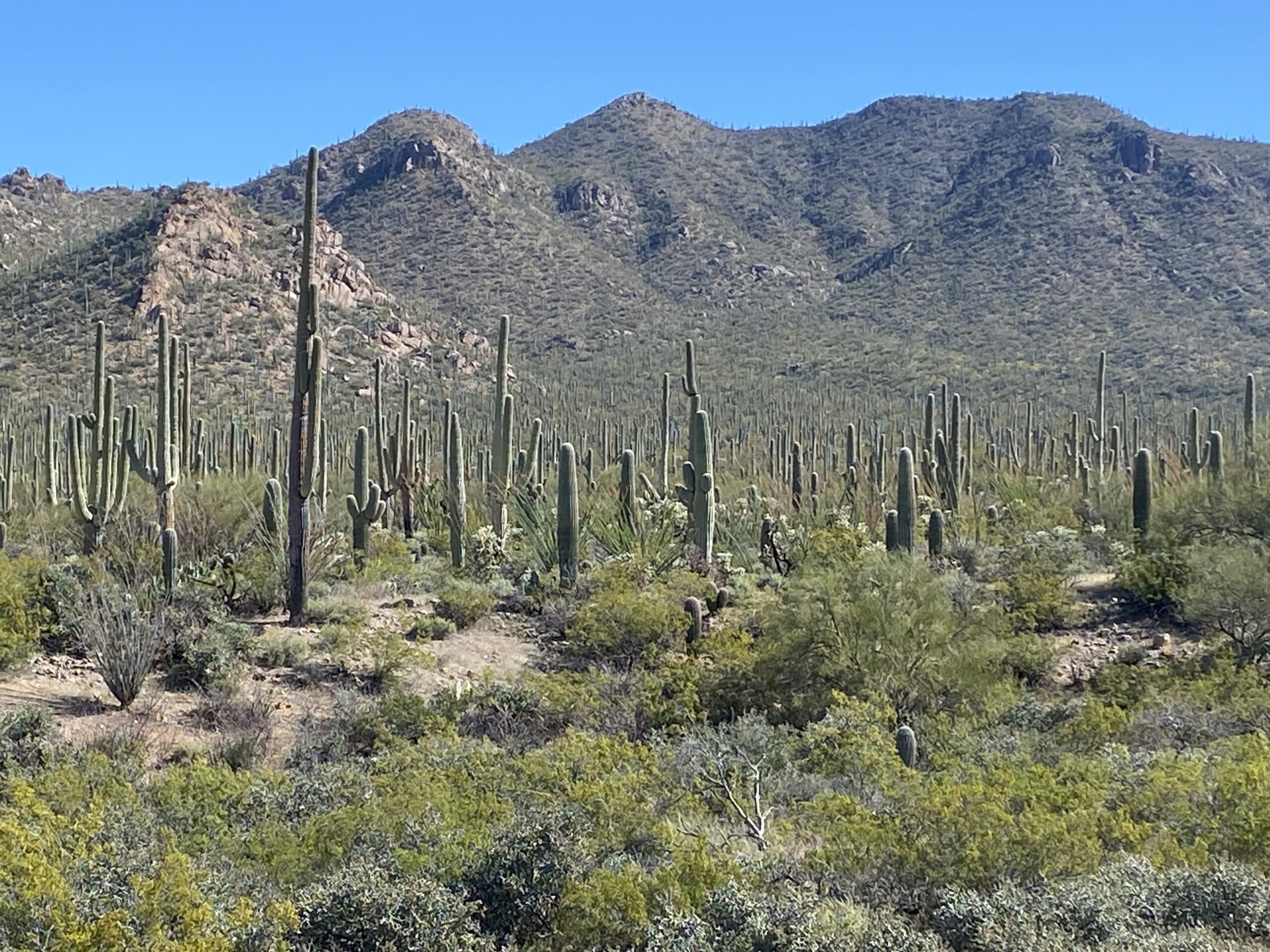Once again weather interrupted our plans, as the road to Chiricahua National Monument, where we had reservations for three nights, was covered by 8 inches of snow. Instead, we drove straight to Tucson and found a campground that bordered on Saguaro National Park.
After a day of running errands and stocking up on food, we visited the western side of the park. Saguaro consists of two areas that aren’t connected, one on the eastern side of Tucson and one on the western. They’re managed as one unit. Visitors often visit one in the morning and the other in the afternoon in a sort of drive-by tour of the park. But both sides are worth much more than a half day’s fleeting glimpse.

The western portion is probably more scenic. It’s hard to fathom just how many of the saguaros are in the park. We started our visit by watching a movie about the park in the visitor center. At the end of the video, the screen rose up, the curtains opened to a large window showcasing a hillside full of the namesake cacti.
Saguaros can live for 150 to 200 years, and they may not grow any arms for 75 to 100 years. The saguaro is the clown prince of cacti, often growing in comical forms. Many look like they’ve raised their fists as if to fight an imaginary foe. Others just look like the desert is giving you the finger.

Saguaros can grow as high as 80 feet, supported by wooden ribs arranged in an accordion style. Those accordion folds allow the cactus to swell as it retains water during wet spells.
After the movie, we drove the scenic Bajada Loop Road through the park, stopping at various points to hike side trails for scenic landscape views in the distance and prickly cacti of various forms up close.

The following morning, I rose early to hike the King Canyon Trail, a 7-mile journey to one of the higher points in the park. Near the summit, I passed a group of hikers with the Mountaineers climbing club out of Seattle, and we had a long chat once they caught up with me at the top.
I couldn’t linger because we had to be out of our campsite by noon. We had just enough time to pack up the trailer and hitch up to the truck, before driving to the northeastern side of Tucson, to Catalina State Park.
That campground put us a little closer to the eastern portion of Saguaro which we visited the next day. It’s not as impressive as the western side, in my opinion, although it does have some longer backcountry trails to explore.

We drove the Cactus Forest Scenic Loop, taking time to hike the Cactus Forest Trail to the site of some former lime kilns, and a waterfall still clinging to the last of the winter snowmelt. It would probably be dry in another month.

The east side of Tucson also boasts the scenic Sabino Canyon. We rode a tram with an audio commentary 4 miles up the paved road to the last stop. But instead of riding the tram back, we hiked what was supposed to be a 5-mile trail back to the start. The Phoneline Trail hugs the canyon wall high above the paved road through the canyon and is never really difficult. But we didn’t realize the trail doesn’t lead back to the visitor’s center. It ended about two miles up another paved road where a tram takes tourists up Bear Canyon.

We spent our last day in Tucson taking care of some paperwork that needed to be notarized and mailed, and I went for a run through Catalina State Park.
The next morning, we broke camp just as the eclipse was occurring. We hadn’t been able to find any eclipse glasses, so we had to ignore the solar spectacle. Fortunately, we weren’t in the path of totality, and we had a seen a 99% eclipse in Bend several years earlier.
We drove off looking forward to connecting with family in Phoenix, having completed three months or exactly a quarter of our year-long road trip. So far, it’s been a blast!
Days: 90
Miles Traveled: 11,784
Next stop: Phoenix, Arizona


